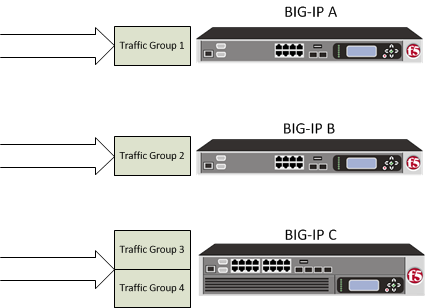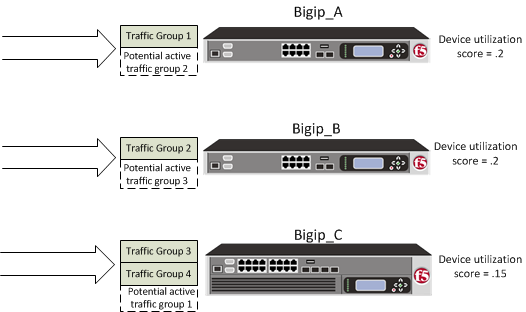Applies To:
Show Versions
BIG-IP AAM
- 12.1.5, 12.1.4, 12.1.3, 12.1.2, 12.1.1
BIG-IP APM
- 12.1.6, 12.1.5, 12.1.4, 12.1.3, 12.1.2, 12.1.1
BIG-IP Analytics
- 12.1.6, 12.1.5, 12.1.4, 12.1.3, 12.1.2, 12.1.1
BIG-IP Link Controller
- 12.1.6, 12.1.5, 12.1.4, 12.1.3, 12.1.2, 12.1.1
BIG-IP LTM
- 12.1.6, 12.1.5, 12.1.4, 12.1.3, 12.1.2, 12.1.1
BIG-IP AFM
- 12.1.6, 12.1.5, 12.1.4, 12.1.3, 12.1.2, 12.1.1
BIG-IP PEM
- 12.1.6, 12.1.5, 12.1.4, 12.1.3, 12.1.2, 12.1.1
BIG-IP DNS
- 12.1.6, 12.1.5, 12.1.4, 12.1.3, 12.1.2, 12.1.1
BIG-IP ASM
- 12.1.6, 12.1.5, 12.1.4, 12.1.3, 12.1.2, 12.1.1
Configuring Load-aware Failover
Overview: Implementing load-aware failover
Load-aware failover is a BIG-IP® feature designed for use in a Sync-Failover device group. Configuring load-aware failover ensures that the traffic load on all devices in a device group is as equivalent as possible, factoring in any differences in device capacity and the amount of application traffic that traffic groups process on a device.
For example, suppose you have a heterogeneous three-member device group in which one device (Bigip_C) has twice the hardware capacity of the other two devices (Bigip_A and Bigip_B).
If the device group has four active traffic groups that each process the same amount of application traffic, then the load on all devices is equivalent when devices Bigip_A and Bigip_B each contain one active traffic group, while device Bigip_C contains two active traffic groups.
The figure shows a Sync-Failover device group where application traffic is directed to the device with the most capacity relative to the other device group members.

Sync-Failover device group with traffic groups of equal load:
The BIG-IP system implements load-aware failover by calculating a numeric, current utilization score for each device, based on numeric values that you specify for each device and traffic group relative to the other devices and traffic groups in the device group. The system then uses this current utilization score to determine which device is the best device in the group to become the next-active device when failover occurs for a traffic group.
The overall result is that the traffic load on each device is as equivalent as possible in a relative way, that is, factoring in individual device capacity and application traffic load per traffic group.
About device utilization calculation
The BIG-IP® system on each device performs a calculation to determine the device's current level of utilization. This utilization level indicates the ability for the device to be the next-active device in the event that an active traffic group on another device must fail over within a heterogeneous device group.
The calculation that the BIG-IP performs to determine the current utilization of a device is based on these factors:
- Device capacity
- A local device capacity relative to other device group members.
- Active local traffic groups
- The number of active traffic groups on the local device.
- Active remote traffic groups
- The number of remote active traffic groups for which the local device is the next-active device.
- A multiplying load factor for each active traffic group
- A multiplier value for each traffic group. The system uses this value to weight each active traffic group's traffic load compared to the traffic load of each of the other active traffic groups in the device group.
The BIG-IP system uses all of these factors to perform a calculation to determine, at any particular moment, a score for each device that represents the current utilization of that device. This utilization score indicates whether the BIG-IP system should, in its attempt to equalize traffic load on all devices, designate the device as a next-active device for an active traffic group on another device in the device group.
The calculation that the BIG-IP performs for each device is:
(The sum of local active traffic group loads + The sum of remote active traffic group loads) / device capacity
Task summary
To implement load-aware failover you specify a value representing the relative traffic load for a traffic group and, optionally, a value representing the relative capacity of the BIG-IP® device.
Task list
Specifying the HA capacity of a device
You perform this task when you have more than one type of hardware platform in a device group and you want to configure load-aware failover. Load-aware failover ensures that the BIG-IP® system can intelligently select the next-active device for each active traffic group in the device group when failover occurs. As part of configuring load-aware failover, you define an HA capacity to establish the amount of computing resource that the device provides relative to other devices in the device group.
Specifying an HA load factor for a traffic group
Implementation Results
For this implementation example, the load-aware configuration now consists of both a user-specified relative high availability (HA) hardware capacity for each device and a relative load factor for each active traffic group.
Using the example in the overview, devices Bigip_A and Bigip_B are the same hardware platform and therefore have the same HA capacity, while Bigip_C has twice the HA capacity of the other two devices. Also, devices Bigip_A and Bigip_B currently have one active traffic group each, while Bigip_C has two active traffic groups. All three traffic groups process the same amount of application traffic.

Device utilization scores based on device capacity and traffic group load
The device utilization score that the BIG-IP® system calculates in this implementation is the sum of all traffic load values on a device divided by the device capacity.
| HA capacity | Active traffic group | HA load factor | Potential active traffic group | HA load factor | Device utilization score |
|---|---|---|---|---|---|
| 10 | Traffic-group-1 | 1 | Traffic-group-2 | 1 | 2/10 = .2 |
| HA capacity | Active traffic group | HA load factor | Potential active traffic group | HA load factor | Device utilization score |
|---|---|---|---|---|---|
| 10 | Traffic-group-2 | 1 | Traffic-group-3 | 1 | 2/10=.2 |
| HA capacity | Active traffic group | HA load factor | Potential active traffic group | HA load factor | Device utilization score |
|---|---|---|---|---|---|
| 20 | Traffic-group-3 and Traffic-group-4 | 1 and 1 | Traffic-group-1 | 1 | 3/20=.15 |
This example shows the results of the calculations that the BIG-IP system performs for each device in the device group. The example shows that although device Bigip_C currently has the two active traffic groups, the device has the most available resource due to having the lowest utilization score of .15. In this case, Bigip_C is most likely the next-active device for the other two devices in the device group.





